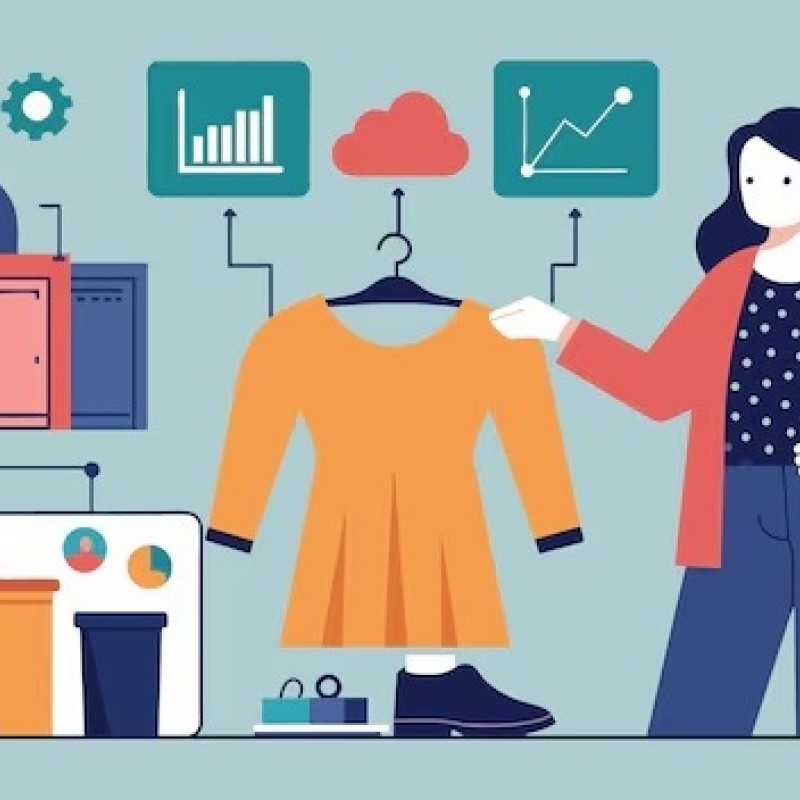Climate change. Carbon emissions. Water shortages. Are you tired of talking about the environment? Don’t be! Pollution and waste are problems everyone should care about, but it’s especially crucial for leaders in fashion because of the industry’s huge carbon footprint and contribution to pollution.
Fashion production is responsible for 10% of global carbon emissions. And in just the past twenty years, the amount of clothing produced has doubled. One of the main issues that experts say will help is reducing the use of plastic in fashion.
This article discusses what plastic fashion is, what solutions exist, who’s getting involved and how you can help.
The term “plastic fashion” can be used for two concepts: textiles being largely made of plastic and clothes made from recycled materials.
At least 60% of clothes today contain plastic, like nylon, acrylic or polyester. And most of it is virgin plastic, meaning it was newly created for clothes. Because plastic is cheaper and easier to produce than natural or sustainable sources, companies use it to increase profits and production.
To reduce plastic waste, innovators have begun making recycled plastic clothing. By breaking down plastic waste into small particles, manufacturers can create recycled polyester, which is used to make new apparel. This form of plastic fashion helps limit the amount of new polyester needed for clothes while also repurposing existing plastic, but this method is not without its challenges.
These steps towards circular fashion are difficult to implement, and some even lead to other types of damage, such as water pollution. If you’re in the fashion industry and want to make a difference in the world, it’s crucial to understand the environmental issues and get involved in sustainability in fashion.
Plastic is unavoidable in our lives, including in fashion. It’s cheap, and it’s used in important materials such as warm fabrics, elastic swimwear and breathable sports clothes. Although the harm of plastic fashion is clear, it’s not easy to fix because of supply and cost issues.
You’ve probably heard about how plastic bottles are filling up the oceans and how plastic waste is killing animals. But did you know that plastic from clothing makes up 16–35% of the microplastics in oceans? When you wash your clothes, you release microfibres into the world’s water supply. The problem with fast fashion is that most microfibres shed during the first few washes. So when you wash an item only a few times and replace it, you increase the number of first washes and the amount of plastic going into wastewater.
Another concern is the harm to human health. We breathe in fibres from fabric and textiles in our clothes, rugs, curtains and couches, and it’s not clear how the chemicals in plastic that touches our skin affects us. Scientists have found bits of plastic inside human bodies, and we although they aren’t sure what the implications are, they know that exposure to chemicals in plastic fashion can lead to health problems, including cancer and DNA damage.
Many methods do exist to reduce plastic fashion, and groups around the world are working towards alternative materials and processes. Here we explain here some of the most successful green trends and solutions taking over in the fashion world.
In this form of plastic fashion, manufacturers break down plastic to create recycled polyester clothes. For example, water bottles become leggings and food containers become shoes. This transformation is great for getting people to think about recycling, but critics have pointed out that these plastic clothes still cause problems. They also release microplastics, and the process often involves water bottles that would otherwise be recycled again into bottles rather than single-use clothes. Despite the concerns, this trend is growing fast, and many are optimistic that further developing this solution will improve overall plastic reduction.
Like recycling, circular fashion aims to use apparel for as long as possible. But what separates it from recycling is its focus on how products start and end. The idea is to design items that are sourced, produced and disposed of cleanly. Longevity and minimalism are key because the overall goal is for people to buy less and companies to produce less. Solutions include any process to extend product life and make fashion cleaner, such as upcycling, prioritising workers’ rights and developing sustainable, ethical fabrics.

One of the best ways to reduce plastic in fashion is to develop alternatives to plastic. Sounds simple, right? It’s not, because budget and production requirements often make using sustainable materials impossible, but researchers and innovators are coming up with solutions. Organic natural materials, like cotton, wool and linen, are great choices for green clothing. But the “organic” part is important because it means that it’s grown, harvested and processed with the lowest impact possible. Regular cotton, for example, is one of the worst offenders because of heavy water and pesticide use. Other game-changers include exciting cutting-edge developments, like fruit leather and adding proteins to fibre to make it recyclable.
Because it’s fashionable to be sustainable, some brands are taking advantage of this trend. Greenwashing is a word to describe to companies that claim to be green but are not. It’s easy to say they’re eco-friendly while not participating in the movement, so be sure to research green brands before supporting them.
You might be surprised at the number of brands truly dedicated to sustainability. Here are few of our favourites, although this list is by no means exhaustive.
This luxury house is well known for being dedicated to circular fashion and removing plastic from the fashion industry. The designer is focused on developing sustainable technologies and protecting ecosystems by using reengineered fabrics, organic cotton and recycled nylon and polyester. Another focus of hers is transparency and education. She’s launched Clevercare, a way to teach consumers about how to increase the clothing’s longevity. She also collaborates with Parley for the Oceans, Wildlife Works and other eco organisations.
Yvon Chouinard recently made headlines when he gave away the company so it could focus on climate change. As you can imagine, Patagonia is heavily involved in sustainability, and although it’s not perfect, it does a great job in several ways. Very little of its material comes from virgin sources, meaning it uses a lot of recycled material to fight against plastic fashion. Durability is of utmost importance, and the company plans to be carbon neutral by 2025. As of the recent ownership change, all profits go towards climate change initiatives.
Although Adidas has some faults in its sustainability efforts and participates in some fast fashion practices, its made amazing progress and is ahead of its competitors in plastic fashion. Adidas has collaborated with Parley for the Oceans to use ocean waste to make products. And the company has committed to stop all virgin plastic use by 2024 and be carbon neutral by 2025, already making strides in reducing CO2 and water consumption.
This new luxury brand, created in 2016, is a frontrunner in responsible environmental practices. It recently partnered with Nudie Jeans to make sustainable denim, and it uses organic cotton and many other eco-friendly materials. Its stand-out practices include focusing on making durable products by hand and becoming carbon neutral. Customers of Bite Studios tend to become loyal, as the brand offers a buyback program and offers transparency in their practices.
Another heavy hitter is Eileen Fisher. She encourages minimalism, she uses natural dyes and organic and recycled materials, and she also runs second-hand initiatives to discourage waste. Reducing plastic in fashion has been one of her top priorities. She’s built a sustainability empire that fights against linear production in several ways, although she recently announced she’s stepping down as CEO.
The answer is yes! Although the most profound changes start with company heads and lawmakers, consumers need to be on board too. To make sustainability efforts more successful, you – as an individual – can work towards reducing plastic in the fashion industry.
1. Buy less clothing: As more people quit fast fashion, companies will change their strategies to follow the trend, hopefully slowing production and pollution. You can get on board by joining the #NoNewClothes campaign and participating in no-buy challenges. By purchasing durable, classic pieces, you’ll have a long-lasting wardrobe that’s less likely to go out of style. It’s also helpful to avoid binge shopping. If you analyse when and why you make impulse purchases, you’ll be able to replace those behaviours with environmentally friendly alternatives.
2. Mend, upcycle and repurpose: These are great ways to get more life out of your clothes. When you patch your jeans, mend your socks or turn a prom dress into a hen-do outfit, you’re not only extending the lifecycle but avoiding buying new plastic fashion items. You can even repurpose clothes to create non-apparel items, like making a dog bed from your old bathrobe. Small changes like this can save you thousands throughout your lifetime and reduce your individual carbon footprint.
3. Swap, rent and go vintage
Buying from second-hand shops lowers consumption, as long as it reduces how much new clothing you buy. By significantly delaying apparel ending up in a landfill or incinerator, you also avoid the high microplastic pollution that new clothes cause. Other options growing in popularity are clothing swaps and rental fashion. As people look for ways to be more sustainable, they’re becoming more open to sharing and less interested in owning lots of clothes.
4. Change your washing habits: Did you know that your plastic clothes will shed less microplastic if you wash them at lower temperatures? And if you wash them less often, use the delicate cycle, and put in less detergent, you can prolong their life and reduce their impact. If you have the option, choose a front-loading washing machine, as they release fewer microfibres. It also helps to clean your lint filter often and instal a microfibre filter.
5. Invest in durable and sustainable apparel: Everyone needs to replace their undergarments or buy new trainers from time to time, but it’s best to avoid elastane, polyester, spandex and viscose. Acrylic is particularly harmful because it releases a lot of microfibres and is not recyclable. Good alternatives include organic hemp, linen or cotton, keeping in mind that “organic” is key. If you must buy clothes with plastic, make sure they’re durable and recyclable. That way, they’ll last for a long time and be cleanly recycled when the time comes.
6. Voice your concerns: Call, email and send letters to fashion brands and elected officials to let them know about your concerns and preferences. It might not feel like a lot, but every voice counts. When enough people raise the same concerns, companies start to take notice.
If you’d like to know more about sustainability efforts in fashion, check out these articles:
https://beyondtalentrecruitment.com/blog/circular-fashion
https://beyondtalentrecruitment.com/blog/work-in-sustainable-fashion
https://beyondtalentrecruitment.com/blog/best-online-resale-clothing-sites
https://beyondtalentrecruitment.com/blog/vegan-luxury-skincare





Beyond Talent
Fashion Recruitment Agency
Specialising in Senior and Executive recruitment for the luxury fashion, lifestyle and beauty industries worldwide.
Head Office Address
20-22 Wenlock Road, London, N1 7GU
Contact Us